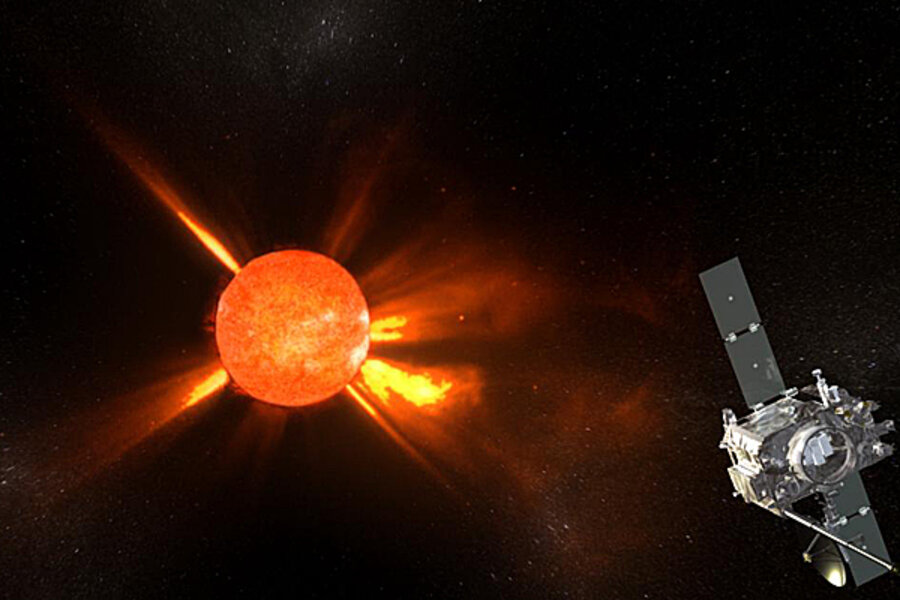NASA captures 3D video of comet plunging into sun
Loading...
| Miami
A comet plunging into the sun has been captured in 3-D as it hurtled along its kamikaze path for the first time, solar physicists announced Monday.
"We believe this is the first time a comet has been tracked in 3-D space this low down in the solar corona," said solar physicist Claire Raftery, a post-doctoral fellow at UC Berkeley.
Four post-doctoral researchers at UC Berkeley's Space Science's Laboratory used instruments aboard NASA's Solar Terrestrial Relations Observatory (STEREO) spacecraft to track the so-called sun-grazing comet as it approached the sun. They were able to estimate an approximate time and place of impact.
NASA's STEREO mission, which launched in 2006, is actually made up of twin spacecraft that orbit the sun, one ahead of the Earth and one behind it, and provide stereo views of the sun.
Close to the sun
Sun-grazing comets are made up of dust, rock and ice. These comets are rarely tracked as they speed toward the sun because their brightness is overwhelmed by the solar disk.
But every now and then, a comet stands out in views from sun-watching spacecraft like STEREO and the Solar and Heliospheric Observatory (SOHO).
The comet seen by Raftery and her fellow researchers apparently survived the intense heat of the sun's outer atmosphere – called the corona – and disappeared in the chromosphere, which is a thin layer of plasma found between the visible surface of the sun and the corona.
The comet eventually evaporated in the scorching heat that reaches almost 180,000 degrees Fahrenheit (close to 100,000 degrees Celsius).
Raftery and her colleagues, Juan Carlos Martinez-Oliveros, Samuel Krucker and Pascal Saint-Hillaire, concluded that the comet was probably from the Kreutz family of comets, a group of Trojan or Greek comets that were ejected from their orbit in 2004 by the gas giant Jupiter.
The researchers also concluded that the sun-grazing comet made its first and only loop around the sun before crashing and burning.
The research team presented their findings today at the 216th meeting of the American Astronomical Society.
Tracking a comet
The comet first caught Martinez-Oliveros' attention after it was mentioned in a summary of observations by SOHO and STEREO in March.
The comet's long, bright tail of dust and ions distinguished it as a sun-grazing comet, and assuming that it was going to loop around the sun, the researchers decided to monitor it and see whether the STEREO data were good enough to allow them to accurately calculate its trajectory.
They found that the data was so precise that they were able to chart the comet's approach for two days prior to impact.
The researchers were able to estimate the impact zone within a circle about 620 miles (1,000 km) in diameter. They then pored through online data from the Mauna Loa Solar Observatory to determine if they could spot the comet next to the sun's edge in the ultraviolet region of the spectrum.
What they found was a short trail that lasted about six minutes and was only a few thousand miles above the solar surface in the sweltering corona and chromosphere.
Since the comet had a relatively short tail – about 1.86 million miles (about 3 million km) in length – the researchers believe that the comet contained heavier elements that do not evaporate as easily.
This would also help explain how the comet was able to penetrate so deeply into the sun's chromosphere, not only surviving the extreme temperatures but the strong solar winds as well, before finally evaporating.
For their study, the team used the two coronagraphs on STEREO A and B and multiple instruments on SOHO, "demonstrating the importance of multi-view observations of non-solar phenomena," the researchers wrote in the presentation of their research.
The researchers also used data from the ground-based Mauna Loa Solar Observatory, located on the flank of the Mauna Loa volcano in Hawaii, and found images of the spot they had predicted the comet to impact at, which appeared to show a comet approaching the edge of the sun from behind the solar disk.
The members of the research team, who all normally study explosive events on the sun, said that their foray into cometary physics was unplanned.
"It was supposed to be an exercise, but it took over our lives," Raftery said.





